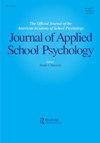Differences between Students with Emotional Disturbance, Learning Disabilities, and without Disabilities on the Five Dimensions of Emotional Disturbance
IF 1.5
Q4 PSYCHOLOGY, EDUCATIONAL
引用次数: 5
Abstract
Abstract The present study investigated evidence of the construct validity of scores from the Scales for Assessing Emotional Disturbance Rating Scale (SAED-3 RS), which is designed to help identify emotional disturbance (ED) as defined by U.S. law and regulations. The purpose of this research was to evaluate the degree to which SAED-3 RS scores differed between students with school-identified ED, students with school-identified learning disabilities (LD), and students without disabilities. The sample consisted of 2,193 K-12 students from throughout the U.S. The findings supported three hypotheses related to evidence of construct validity: (1) students with ED would differ from students without disabilities on all five dimensions of the SAED-3 RS; (2) students with ED would differ from students with LD on all dimensions of the SAED-3 RS except for the Inability to Learn dimensions; and (3) students with LD would differ from students without disabilities on all five dimensions of the SAED-3 RS, but that these differences would be smaller than the differences between students with ED and students without disabilities. Implications for practice and directions for future research are also discussed.情绪障碍、学习障碍和无障碍学生在情绪障碍五个维度上的差异
摘要本研究调查了情绪障碍评定量表(SAED-3RS)得分结构有效性的证据,该量表旨在帮助识别美国法律法规定义的情绪障碍(ED)。本研究的目的是评估学校认定ED学生、学校认定学习障碍(LD)学生和非残疾学生之间SAED-3 RS分数的差异程度。样本包括2193个 来自美国各地的K-12学生。研究结果支持了与结构有效性证据相关的三个假设:(1)ED学生在SAED-3 RS的所有五个维度上都与非残疾学生不同;(2) 患有ED的学生在SAED-3 RS的所有维度上都与患有LD的学生不同,除了学习能力维度;以及(3)在SAED-3 RS的所有五个维度上,患有LD的学生与非残疾学生都会有所不同,但这些差异会小于患有ED的学生与无残疾学生之间的差异。对实践的启示和未来研究的方向也进行了讨论。
本文章由计算机程序翻译,如有差异,请以英文原文为准。
求助全文
约1分钟内获得全文
求助全文
来源期刊

Journal of Applied School Psychology
PSYCHOLOGY, EDUCATIONAL-
CiteScore
2.40
自引率
10.00%
发文量
7
期刊介绍:
With a new publisher (Taylor & Francis) and a new editor (David L. Wodrich), the Journal of Applied School Psychology will continue to publish articles and periodic thematic issues in 2009. Each submission should rest on either solid theoretical or empirical support and provide information that can be used in applied school settings, related educational systems, or community locations in which practitioners work. Manuscripts appropriate for publication in the journal will reflect psychological applications that pertain to individual students, groups of students, teachers, parents, and administrators. The journal also seeks, over time, novel and creative ways in which to disseminate information about practically sound and empirically supported school psychology practice.
 求助内容:
求助内容: 应助结果提醒方式:
应助结果提醒方式:


